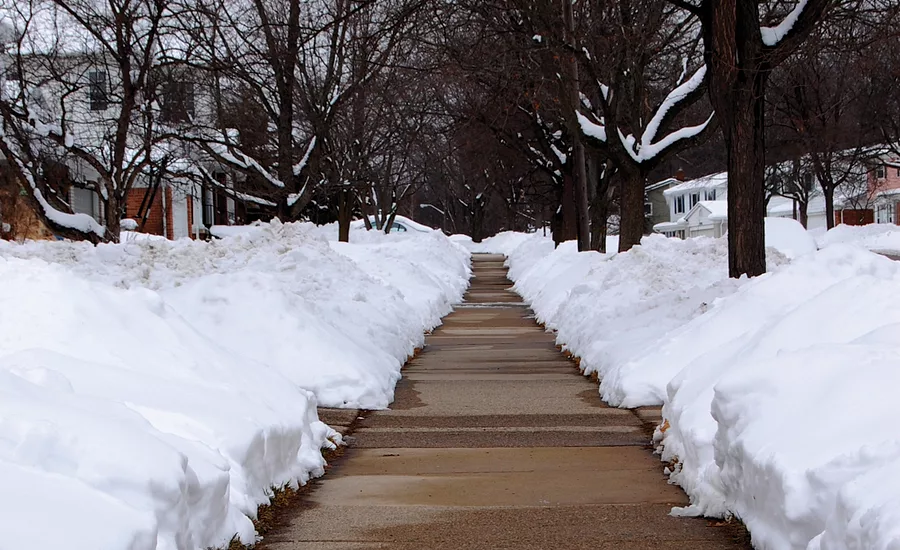The politics of snow-melt systems
“So how do you figure your return on investment?”

A few months ago, I spotted a news story about Maryland Gov. Larry Hogan, who happens to be a Republican. He was catching heat from the opposing party over a new snow-melt system for a brick walkway at the governor’s mansion. It was politics as usual.
Doug Mayer, who is the governor’s spokesman, said this was a common-sense project that would extend the life of the walkway and save money as time went by. He explained the governor had nothing to do with the planning of this snow-melt job, but that didn’t matter. The opposition jumped all over him. They saw snow melt as a luxury item, even though it was going to pay for itself in five years and continue to save money and offer many other benefits as time went by. The walkway was going to last a lot longer, but none of that mattered. It was a political opportunity to pounce.
I remember looking at a snow-melt system under some sidewalks in Stockholm. This was near the end of December 1990. I was mesmerized by it. I asked one of the engineers I was visiting about it.
“How can you afford to do this?” I asked.
“How can we afford not to do this?” he answered, and then he explained the reasoning behind it all, which made me see the light.
After the Hogan story came out, I asked my friend Jodi Smits Anderson for her thoughts. Jodi is my favorite architect in the entire world. She has no problem saying what she thinks, and she is smart enough to have starred in a TEDx talk. Jodi is the director of sustainability programs for the Dormitory Authority of the State of New York. DASNY began in 1944 and is one of the largest financiers and builders of social infrastructure facilities in the U.S. She knows what she’s doing.
“So what do you think about Gov. Hogan and his snow-melt situation?” I asked.
“Oh, you know I have something to say about this!” she said.
“I’m listening.”
“I would recommend snow melt in every capital project involving sidewalks in a snowy area, and this is where complete triple-bottom-line thinking is much smarter than simply asking if it saves energy.”
“So DASNY has been using it?”
“Yes. DASNY has an under-sidewalk snow-melt system.”
“Tell me about it. How large is it? What did it cost?”
“Sure. The piping in the sidewalk and the building, the heat exchanger and accessories, and the installation cost totaled $50,000. This is for a sidewalk system covering about 3,000 square feet. However, this was part of a more extensive sidewalk replacement project that included the sidewalk substrate and the pavers, which would have been done anyway. The total for the whole project was about $176,000.”
Figure the ROI
“So how do you figure your return on investment?”
“Good question. I used the $50,000 info as the incremental investment over what would normally have occurred. In addition, it costs up to $3,000 per year to run the system, but on a side note, we run it backwards in the hottest summer days to pre-warm our domestic hot water system and avoid fossil fuel use. I don’t have any confirmed numbers for this, though.
“So, costs are $50,000 out of the gate, and let’s say $2,500 yearly to operate the system. We avoid $2,500 per year in costs for staff overtime, $5,000 per year for salt and chemicals, and $1,000 per year for cleaning the salt and chemicals off the floor mats. That equals an ROI of 0.12. Or, put another way, in just eight years, we’re back to saving money.”
“That’s impressive!”
“It is, and we’ve reaped other significant benefits from it for nearly 20 years,” she said.
“Tell me about that.”
“Well, first our sidewalk of concrete bricks has no spalling or heaving, unlike most of the neighboring sidewalks.”
“Have the neighbors noticed?” I asked.
“Yes, a large building just one block away from us has no snow-melt system. Their sidewalk is full of gaps and replaced bricks, and they used cheap, poorly colored concrete for the fixes. It looks horrible.”
“What else have you learned?”
“We’ve eliminated the need for ice-melt chemicals and salts, and that’s been good for the Hudson River, which is also just one block away from us. All the runoff goes right into the storm sewer and down into the river.”
“Tell me more,” I said.
“Our trees in the sidewalk are healthy and haven’t needed any special care or replacement. Many other city trees have died off because of the salt and the chemicals. What a shame that is.”
“I agree.”
“And I mentioned the washing we used to have to do for our walk-in mats. We cut that by 80%, and that’s a savings we see over and over again every year. It also reduces the environmental burden in heat and cleaning process as well as use of petrochemical cleaners.”
“That’s something most people wouldn’t consider.”
“I know,” Jodi said. “There’s a lot most people don’t consider. Take our 20-year-old lobby, for instance. It has granite flooring and it looks as good as it did the day we opened because there are no chemicals or salts being tracked in to tear apart our building materials. The same goes for the carpeting on the above-grade floor. Many people comment on this durability, and it is all because there are no salts or chemicals on our sidewalks. Seriously.”
Things to consider
“Anything else?” I asked.
“Our air quality in the building is better. That’s something else most people don’t consider. We’ve also eliminated having to pay that overtime to the staff for shoveling snow and breaking up ice. That’s a huge savings.”
“And I’ll bet fewer employees get hurt if they’re not shoveling heavy snow,” I said.
“Absolutely! We’ve reduced risk to the maintenance staff. Snow and ice removal is one of the most physically damaging aspects of facility management. And we’ve totally eliminated the risk of slip-and-fall occurrences on our property. This is also huge. One slip and fall accident brings up to a $2 million liability risk because we own the sidewalk. This was the single most compelling factor in deciding to install this system in the first place.”
“So do you think more people should be looking at snow melt?”
“Yes, it’s a seriously undervalued approach. We have one State University of New York college that requires snow-melt systems in all capital projects. They see the daily benefits because they’re in Brockport, which is near Buffalo. They get some serious snow there.”
“Thanks, Jodi. I always get smarter when I listen to you. Any final thoughts you’d like to share?”
“Yes. Let’s not forget that my shoes last longer!”
Sadly, many laypeople continue to see snow melt as a luxury item. They see it that way because no one has taken the time to explain to them what Jodi just explained to us.
And, surprisingly, many in the trade who are supposed to be educated in things hydronic and electrical also see snow melt solely as a luxury item. And because they think they can’t afford it, they do their best to talk potential customers out of giving them snow-melt business.
They do this because they’re knuckleheads.
But back to the politics of this seeming luxury.
State Delegate Eric Luedtke, a Democrat out of Montgomery County, Maryland, commented on social media that Hogan, a Republican, was adding what amounts to a luxury item to the state grounds of the governor’s mansion. He said this is a feature common to fancy ski resorts and plush Manhattan apartment buildings.
“The governor cuts $6 million for school construction, and he gets heated sidewalks?” Luedtke gasped.
I think this guy should get in his car and go sit with Jodi Smits Anderson for a while.
But that wouldn’t be politically expedient, would it?
Looking for a reprint of this article?
From high-res PDFs to custom plaques, order your copy today!






